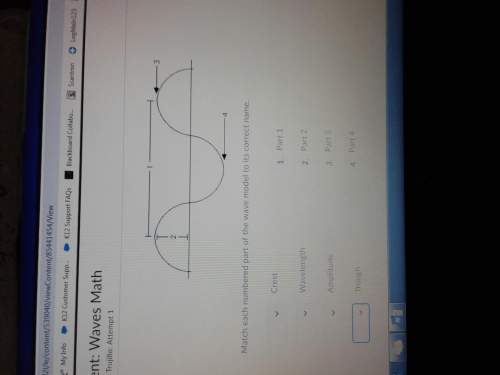
Physics, 25.07.2019 11:00 constipatedcow18
What force causes a moving object to move in a curved or circular path?

Answers: 1


Another question on Physics

Physics, 21.06.2019 17:20
American eels (anguilla rostrata) are freshwater fish with long, slender bodies that we can treat as uniform cylinders 1.0 m long and 10 cm in diameter. an eel compensates for its small jaw and teeth by holding onto prey with its mouth and then rapidly spinning its body around its long axis to tear off a piece of flesh. eels have been recorded to spin at up to 14 revolutions per second when feeding in this way. although this feeding method is costly in terms of energy, it allows the eel to feed on larger prey than it otherwise could. 1.a field researcher uses the slow-motion feature on her phones camera to shoot a video of an eel spinning at its maximum rate. the camera records at 120 frames per second. through what angle does the eel rotate from one frame to the next? 2. the eel is observed to spin at 14 spins per second clockwise, and 10 seconds later it is observed to spin at 8 spins per second counterclockwise. what is the magnitude of the eels average angular acceleration during this time? 3. the eel has a certain amount of rotational kinetic energy when spinning at 14 spins per second. if it swam in a straight line instead, about how fast would the eel have to swim to have the same amount of kinetic energy as when it is spinning? 4.a new species of eel is found to have the same mass but one-quarter the length and twice the diameter of the american eel. how does its moment of inertia for spinning around its long axis compare to that of the american eel?
Answers: 1

Physics, 21.06.2019 19:30
Two identical 82 mg dust particles very far apart (pee 0) are moving directly toward each other at a speed of 3698 m/s. the charge on each is-719 ? c. determine how close they will get to each other. let k = 9x109 n-m2/c2 & ignore gravity.
Answers: 1

Physics, 22.06.2019 00:30
Consider an ordinary, helium-filled party balloon with a volume of 2.2 ft3. the lifting force on the balloon due to the outside air is the net resultant of the pressure distribution exerted on the exterior surface of the balloon. using this fact, we can derive archimedes’ principle, namely that the upward force on the balloon is equal to the weight of the air displaced by the balloon. assuming that the balloon is at sea level, where the air density is 0.002377 slug/ft3, calculate the maximum weight that can be lifted by the balloon. note: the molecular weight of air is 28.8 and that of helium is 4.
Answers: 2

Physics, 22.06.2019 07:00
Which statement is best supported by the information in the chart? wave y is moving the fastest. wave x is moving the fastest. all of the waves are moving at the same speed. all of the waves have the same value of wavelengths per second.
Answers: 3
You know the right answer?
What force causes a moving object to move in a curved or circular path?...
Questions

Mathematics, 29.10.2019 07:31

Biology, 29.10.2019 07:31

History, 29.10.2019 07:31




Mathematics, 29.10.2019 07:31

Mathematics, 29.10.2019 07:31




History, 29.10.2019 07:31

History, 29.10.2019 07:31


History, 29.10.2019 07:31


History, 29.10.2019 07:31


Social Studies, 29.10.2019 07:31





